Book contents
- Frontmatter
- Contents
- Preface
- Acknowledgments
- Part I Introducing steps to astronomy
- Part II The Solar System
- Part III Introducing stars
- Part IV Introducing galaxies and the Universe
- Epilog
- Appendix I The small-angle formula
- Appendix II Exponential notation
- Appendix III The Solar System
- Appendix IV The closest and brightest stars
- Appendix V Physical and astronomical constants
- Appendix VI Conversion factors
- Appendix VII Constellation maps
- Glossary
- Figure Credits
- Index
- Plate section
Part I - Introducing steps to astronomy
Published online by Cambridge University Press: 05 February 2013
- Frontmatter
- Contents
- Preface
- Acknowledgments
- Part I Introducing steps to astronomy
- Part II The Solar System
- Part III Introducing stars
- Part IV Introducing galaxies and the Universe
- Epilog
- Appendix I The small-angle formula
- Appendix II Exponential notation
- Appendix III The Solar System
- Appendix IV The closest and brightest stars
- Appendix V Physical and astronomical constants
- Appendix VI Conversion factors
- Appendix VII Constellation maps
- Glossary
- Figure Credits
- Index
- Plate section
Summary
Introducing steps to astronomy
Astronomy was the first science. Indeed, it is older than science. Thousands of years before the scientific revolution, thousands of years before telescopes and modern chemistry, geology and physics, people gazed at the sky and realized there was a lot going on up there to think about.
We begin our study of astronomy by considering what you can see with your naked eye. The daily passage of the Sun across the sky, the phases of the Moon, eclipses and the migration of the Sun across the constellations – all these regularities cry aloud for explanation, and they hint of a great cosmic structure. Early ideas of this structure – we now call it the Solar System – were formulated by ancient peoples, and they persisted for millennia.
Eventually these ideas were overthrown in the scientific revolution. We will trace briefly the course of this revolution, but in doing so our concern is not really historical. Our actual concern is to illuminate the nature of science through a study of its origins. Science is a way of thinking, a way of looking at the world, that was unique in the history of thought. Nothing more vividly illustrates the remarkable nature of science than a study of how it differs from what came before.
With the work of Isaac Newton the scientific revolution reached its climax. In his magisterial Mathematical Principles of Natural Philosophy this extraordinary genius set forth principles that govern the workings of the cosmos. We will devote an entire chapter to Newton’s laws of motion and of gravitation, the single most important force operating in the astronomical universe.
- Type
- Chapter
- Information
- Understanding the UniverseAn Inquiry Approach to Astronomy and the Nature of Scientific Research, pp. 1 - 2Publisher: Cambridge University PressPrint publication year: 2013



